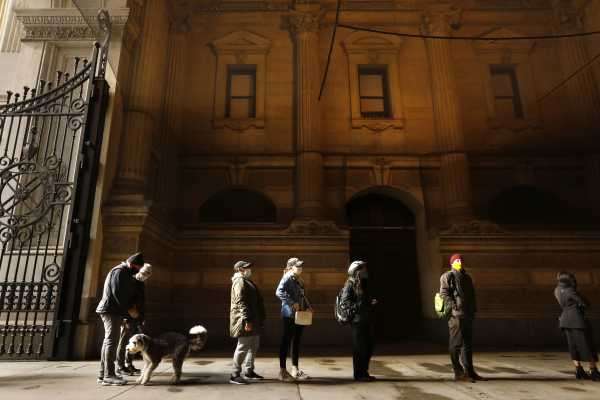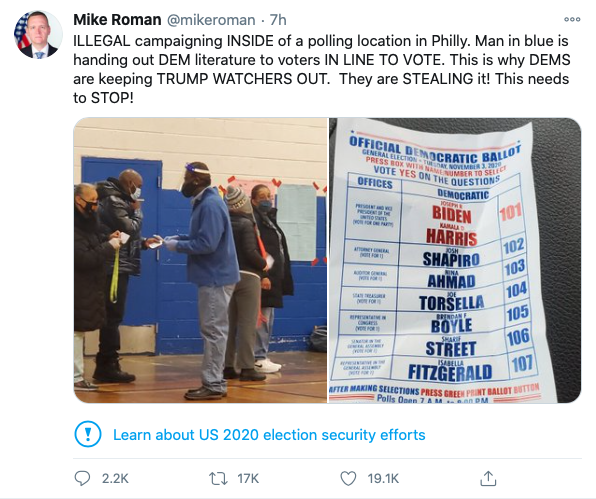
This story is part of a group of stories called

Uncovering and explaining how our digital world is changing — and changing us.
Just hours after the polls opened, misleading claims about voting in Pennsylvania, a key battleground state in the presidential election, were running rampant on social media platforms like Twitter and Facebook. The flurry of social media posts focused on alleged examples of voter suppression and polling location malfeasance, such as broken voting machines and ballots being discarded.
Conservatives — including the official Philadelphia Republican Party, Trump campaign operative Mike Roman, and right-wing media personalities — spread some of these posts on Twitter and Facebook, framing them as indicative of a widespread plot to harm Trump’s campaign. Some of the accusations have been disputed by election officials but continue to proliferate on social media. Local officials such as the Philadelphia District Attorney’s Office called one of Roman’s tweets about Democratic Party signs outside a polling station “deliberately deceptive,” and Twitter has put a warning label on at least one of Roman’s recent posts.

By the time the Philadelphia District Attorney’s office disputed Roman’s tweet, it had already been widely shared.
While it’s hard to fact-check every one of the claims, election researchers say that, even when true, the accusations of wrongdoing are being deceptively exploited to discredit the entire voting process. For months, President Trump has been sowing doubt about the integrity of mail-in voting, despite the fact that there is virtually no evidence of mass mail-in ballot fraud in the United States. Now, it seems that some conservatives are turning their focus to unsubstantiated allegations of mayhem at the in-person polling booths and at drop-off ballot boxes.
“Bad actors have really set the stage leading up to this to be able to amplify true information in a misleading way,” said Maddy Webb, a researcher with First Draft News, an organization that studies the spread of misinformation online. “Our voting system is not infallible, occasionally there are mistakes.” But that doesn’t mean there is “widespread, intentional, malfeasant voter fraud — that just isn’t the case,” she added.
In particular, the hashtag #StopTheSteal has been linked to misleading allegations of mass electoral fraud. From 8 am to 11 am ET, the hashtag appeared on as many as 3,000 tweets per hour, according to First Draft News. The hashtag was driven primarily by a single tweet showing a video of a poll observer being denied entry to a Philadelphia polling location. A voting official in the city told ProPublica that this was an isolated incident and that the watcher was ultimately admitted to the site — but that didn’t stop the video from going viral and stirring up anger.
Another popular thread of misinformation circulating on social media has been around how ballot boxes work in Pennsylvania as well as whether voting machines are working or not and what poll workers might be doing to influence the vote.
Some of the most egregiously false claims were that poll machine booths in Scranton, Pennsylvania, were not working in the afternoon (an election official told Davey Alba at The New York Times there was only a temporary glitch that was fixed by 9 am), and that a person alleging to be a poll worker confessed to throwing away 100 Trump ballots (the person is in fact not a poll worker, according to local election officials).
In particular, researchers at both First Draft News and Zignal Labs, an online intelligence firm, noticed an unusual spike in social media posts Tuesday morning about alleged Philadelphia voting malfeasance using the hashtag #StopTheSteal.
First appearing in 2016, the Stop the Steal campaign was originally linked to former Trump campaign operative Roger Stone. Since then, it’s also been used by liberal activists. But beginning this morning, it exploded when conservative social media accounts with hundreds of thousands of followers like Will Chamberlain, editor-in-chief of the conservative publication Human Events, tweeted about Pennsylvania polling incidents using the hashtag. Zignal Labs estimated the hashtag raked in nearly 13,000 mentions on social media in the course of several hours Tuesday morning.
Altogether, this torrent of confusion — even if it’s eventually corrected by fact-checkers and election officials — serves to chip away at people’s confidence in the electoral process.
“It’s what we’ve seen this entire year, which is complete erosion of faith in any institution — I can’t see a circumstance where people are not going to contest the election,” said Webb, “And this is just piling on even more that election results are not to be trusted.”
Will you help keep Vox free for all?
The United States is in the middle of one of the most consequential presidential elections of our lifetimes. It’s essential that all Americans are able to access clear, concise information on what the outcome of the election could mean for their lives, and the lives of their families and communities. That is our mission at Vox. But our distinctive brand of explanatory journalism takes resources. Even when the economy and the news advertising market recovers, your support will be a critical part of sustaining our resource-intensive work. If you have already contributed, thank you. If you haven’t, please consider helping everyone understand this presidential election: Contribute today from as little as $3.
Sourse: vox.com





